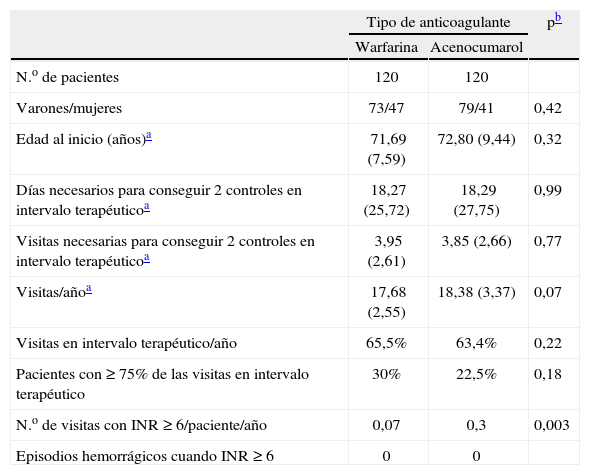Los anticoagulantes orales de vida media larga han mostrado mayor estabilidad en la anticoagulación y menor riesgo hemorrágico que los de vida media corta. En el presente estudio se ha comparado la estabilidad terapéutica y el riesgo hemorrágico del acenocumarol con la warfarina en 2 grupos de pacientes cuya indicación para la anticoagulación oral fue la fibrilación auricular (cociente internacional normalizado [INR]: 2-3).
Pacientes y métodoSe han recogido los datos de 120 pacientes tratados con acenocumarol y 120 tratados con warfarina que habían iniciado y proseguido el tratamiento en nuestro hospital durante un mínimo de un año.
ResultadosEl porcentaje de visitas con INR en intervalo terapéutico en el período de un año fue del 65,5% con la warfarina y del 63,4% con el acenocumarol. El 30% de los pacientes con warfarina tenía en el 75% o más de sus visitas el INR en intervalo terapéutico, frente al 22,5% de los tratados con acenocumarol. En el grupo del acenocumarol, 0,3 visitas/paciente/año presentaba un INR de 6 o superior, frente a 0,07 en el grupo de la warfarina (p=0,003).
ConclusionesLos pacientes tratados con acenocumarol tienen un mayor riesgo de alcanzar INR de 6 o superior. No se aprecian diferencias estadísticamente significativas en la estabilidad terapéutica.
Long half life oral anticoagulants have shown a higher anticoagulation stability and a lower hemorragic risk than those of a short half life. We have compared therapeutic stability and hemorragic risk of acenocoumarol versus warfarin in 2 groups of patients on preventive anticoagulation because of atrial fibrilation (international normalised ratio [INR]: 2-3)
Patients And MethodData on 120 patients treated with acenocoumarol and 120 on warfarin treatment who had started and continued treatment in our hospital for a minimum of a year was collected.
ResultsThe percentage of visits within the intended range of INR (2 to 3) was 65.5% with warfarin and 63.4% with acenocoumarol. Thirty percent of patients on warfarin had 75% or more of their controls within range, while for those treated with acenocoumarol this percentage was 22.5%. In the acenocoumarol group, 0.3 visits/patient/year presented an INR≥6 versus 0.07 in the warfarin group (p=0.003).
ConclusionsPatients treated with acenocoumarol show a higher risk of presenting with an INR ≥ 6, but no statistically significant differences are observed in therapeutic stability.
Artículo
Comprando el artículo el PDF del mismo podrá ser descargado
Precio 19,34 €
Comprar ahora







